Cryomorphological Topographies in the Study of Ice Caves
Abstract
:1. Introduction
2. Study Area and Studied Topic
3. State of the Art in Ice Caves
4. Materials and Methods
4.1. Automatic Cameras
4.2. Cryomorphological Topographies Legend
5. Results and Discussion
5.1. Tridimensional Models Derived from TLS Surveys
5.2. Extraction of Partial Views and Orthoimages
5.3. Thematic Cartographies: Temperature Maps
5.4. Cryomorphological Topographies
6. Conclusions
Author Contributions
Funding
Acknowledgments
Conflicts of Interest
References
- De Sanjosé, J.; Berenguer, F.; Atkinson, A.; De Matías, J.; Serrano, E.; Gómez-Ortiz, A.; González-García, M.; Rico, I. Geomatics techniques applied to glaciers, rock glaciers, and ice patches in Spain (1991–2012). Geogr. Ann. Ser. A Phys. Geogr. 2014, 96, 307–321. [Google Scholar] [CrossRef]
- Gómez-Gutiérrez, Á.; de Sanjosé-Blasco, J.; de Matías-Bejarano, J.; Berenguer-Sempere, F. Comparing two photo-reconstruction methods to produce high density point clouds and dems in the Corral del Veleta rock glacier (Sierra Nevada, Spain). Remote Sens. 2014, 6, 5407–5427. [Google Scholar] [CrossRef]
- Gómez-Ortiz, A.; Oliva, M.; Salvador-Franch, F.; Salvà-Catarineu, M.; Palacios, D.; de Sanjosé-Blasco, J.; Tanarro-García, L.M.; Galindo-Zaldívar, J.; de Galdeano, C.S. Degradation of buried ice and permafrost in the Veleta cirque (Sierra Nevada, Spain) from 2006 to 2013 as a response to recent climate trends. Solid Earth 2014, 5, 979–993. [Google Scholar] [CrossRef] [Green Version]
- Avian, M.; Kellerer-Pirklbauer, A.; Lieb, G. Geomorphic consequences of rapid deglaciation at Pasterze glacier, Hohe Tauern range, Austria, between 2010 and 2013 based on repeated terrestrial laser scanning data. Geomorphology 2018, 310, 1–14. [Google Scholar] [CrossRef]
- Basantes, J.; Godoy, L.; Carvajal, T.; Castro, R.; Toulkeridis, T.; Fuertes, W.; Aguilar, W.; Tierra, A.; Padilla, O.; Mato, F.; et al. Capture and processing of geospatial data with laser scanner system for 3D modeling and virtual reality of amazonian caves. In Proceedings of the 2017 IEEE Second Ecuador Technical Chapters Meeting (ETCM), Salinas, Ecuador, 16–20 October 2017; pp. 1–5. [Google Scholar]
- Obradovic, M.; Abu Zeid, N.; Bignardi, S.; Bolognesi, M.; Peresani, M.; Russo, P.; Santarato, G. High resolution geophysical and topographical surveys for the characterisation of fumane cave prehistoric site, Italy. In Proceedings of the Near Surface Geoscience 2015—21st European Meeting of Environmental and Engineering Geophysics, Turin, Italy, 6–10 September 2015. [Google Scholar]
- Cosso, T.; Ferrando, I.; Orlando, A. High-precision laser scanning for cave tourism 3D reconstruction of the Pollera cave, Italy. Gim Int. Worldw. Mag. Geomat. 2015, 29, 23–25. [Google Scholar]
- Iturbe, A.; Cachero, R.; Cañal, D.; Martos, A. Virtual digitization of caves with parietal paleolithic art from Bizkaia. Scientific analysis and dissemination through new visualization techniques. Virtual Archaeol. Rev. 2018, 9, 57–65. [Google Scholar] [CrossRef]
- Balch, E.S. Glacieres, or Freezing Caverns; Allen Lane & Scott: Philadelphia, PA, USA, 1900. [Google Scholar]
- Girardot, A.; Trouillet, L. La Glacière de Chaux-Les-Passavant. Mem. Soc. Emul. Doubs 1885, 5, 449–524. [Google Scholar]
- Browne, G.F. Ice-Caves of France and Switzerland: A Narrative of Subterranean Exploration; Longmans, Green and Company: London, UK, 1865. [Google Scholar]
- Thuri, H. Etude Des Glacières Naturelles; Archives des sciences de la bibliothèque universelle: Geneve, Switzerland, 1861. [Google Scholar]
- Girod-Chantrans, J. Sur la Glacière Naturelle de Chaux, a 6 Lieues de Besançon; Journal des Mines, Prairial: Paris, France, 1796; Volume 19, pp. 65–72. [Google Scholar]
- Billerez, M. Description de la Glacière Naturelle du Comté de Bourgogne; Histoire de l’Académie Royale des Sciences: Paris, France, 1712; Volume 23, pp. 21–24. [Google Scholar]
- Kern, Z.; Perşoiu, A. Cave ice–the imminent loss of untapped mid-latitude cryospheric palaeoenvironmental archives. Quat. Sci. Rev. 2013, 67, 1–7. [Google Scholar] [CrossRef] [Green Version]
- Luetscher, M.; Jeannin, P.-Y. A process-based classification of alpine ice caves. Theor. Appl. Karstol. 2004, 17, 5–10. [Google Scholar]
- Maire, R. La Haute Montagne Calcaire: Karsts, Cavités, Remplissages, Quaternaire, Paléoclimats; Editions Gap: Challes-Les-Eaux, France, 1990. [Google Scholar]
- Gómez-Lende, M.; Serrano, E. Morfologías, tipos de hielo y regímenes térmicos. Primeros estudios en la cueva helada de Peña Castil (Picos de Europa, Cordillera Cantábrica). Av. Geomorfol. España 2010, 2012, 613–616. [Google Scholar]
- Urdea, P. Permafrost and Periglacial Forms in the Romanian Carpathians. In Proceedings of the 6th International Conference on Permafrost, South China University of Technology, Beijing, China, 5–9 July 1993; pp. 631–637. [Google Scholar]
- Ford, D.C.; Williams, P.W. Karst Geomorphology and Hydrology; Unwin Hyman: London, UK, 1989; Volume 601. [Google Scholar]
- Harris, S.A. Ice caves and permafrost zones in southwest Alberta (Eishöhlen und permafrost in Südwest-Alberta). Erdkunde 1979, 33, 61–70. [Google Scholar] [CrossRef]
- Ballantyne, C.K. Periglacial Geomorphology, 1st ed.; Wiley-Blackwell: Hoboken, NJ, USA, 2018. [Google Scholar]
- Serrano, E.; Gómez Lende, M. Underground permafrost conditions in Picos de Europa high mountain: The ice caves. In Proceedings of the 4th European Conference on Permafrost, Universidad de Lisboa-Universidad de Évora, Évora, Portugal, 18–21 June 2014. [Google Scholar]
- Žák, K.; Onac, B.P.; Kadebskaya, O.I.; Filippi, M.; Dublyansky, Y.; Luetscher, M. Cryogenic mineral formation in ice caves. In Ice Caves; Persoiu, A., Lauritzen, S.E., Eds.; Elsevier: Oxford, UK, 2018; pp. 123–162. [Google Scholar]
- Obu, J.; Košutnik, J.; Overduin, P.; Boike, J.; Zwieback, S. Subterranean periglacial landforms in ledena jama pod hrušico cave, slovenia. In Proceedings of the XI International Conference on Permafrost, Universitat Postdam-Alfred Weneger Institut, Postdam, Germany, 20–24 June 2016; Universitat Postdam-Alfred Weneger Institut: Postdam, Germany, 2016; p. 77. [Google Scholar]
- Milovský, R.; Orvošová, M.; Milovská, S.; Surka, J.; Herich, P.; Biron, A.; Mikus, T. Heterochronous populations of cryogenic cave calcite may reflect depth of permafrost thawing events. In Proceedings of the XI International Conference on Permafrost, Universitat Postdam-Alfred Weneger Institut, Postdam, Germany, 20–24 June 2016; p. 331. [Google Scholar]
- Luhová, L.; Milovský, R.; Orvošová, M.; Milovská, S.; Surka, J.; Herich, P.; Chou, C.Y.; Shen, C.C. Broken stalagmites may be an indicator of permafrost thawing. In Proceedings of the XI International Conference on Permafrost, Universitat Postdam-Alfred Weneger Institut, Postdam, Germany, 20–24 June 2016. Volume Book of abstracts. [Google Scholar]
- Luetscher, M.; Hoffmann, D.; Frisia, S.; Sattler, B.; Spötl, C. Reconstructing permafrost thaw events from alpine cave systems. In Proceedings of the XI International Conference on Permafrost, Universitat Postdam-Alfred Weneger Institut, Postdam, Germany, 20–24 June 2016. Volume Book of abstracts. [Google Scholar]
- Dublyansky, Y.; Kadebskaya, O.; Luetscher, M.; Cheng, H.; Kolta, G.; Spötl, C. Tracking the southern boundary of the late pleistocene permafrost in the Ural mountains using cryogenic cave carbonates: A feasibility study. In Proceedings of the XI International Conference on Permafrost, Universitat Postdam-Alfred Weneger Institut, Postdam, Germany, 20–24 June 2016; Volume Book of abstracts. p. 319. [Google Scholar]
- Spötl, C.; Cheng, H. Holocene climate change, permafrost and cryogenic carbonate formation: Insights from a recently deglaciated, high-elevation cave in the Austrian Alps. Clim. Past 2014, 10, 1349. [Google Scholar] [CrossRef] [Green Version]
- Žák, K.; Onac, B.P.; Perşoiu, A. Cryogenic carbonates in cave environments: A review. Quat. Int. 2008, 187, 84–96. [Google Scholar] [CrossRef]
- Žák, K.; Urban, J.; Cılek, V.; Hercman, H. Cryogenic cave calcite from several central european caves: Age, carbon and oxygen isotopes and a genetic model. Chem. Geol. 2004, 206, 119–136. [Google Scholar] [CrossRef]
- Bartolomé, M.; Sancho, C.; Osácar, M.C.; Moreno Caballud, A.; Leunda, M.; Spötl, C.; Luetscher, M.; López Martínez, J.; Belmonte, A. Characteristics of cryogenic carbonates in a pyrenean ice cave (northern Spain). Geogaceta 2015, 58, 107–110. [Google Scholar]
- Gómez-Lende, M.; Serrano, E.; Jordá, L.; Sandoval, S. The role of gpr techniques in determining ice cave properties: Peña castil ice cave, Picos de Europa. Earth Surf. Process. Landf. 2016, 41, 2177–2190. [Google Scholar] [CrossRef]
- Gomez Lende, M.; Berenguer, F.; Serrano, E. Morphology, ice types and thermal regime in a high mountain ice cave. First studies applying terrestrial laser scanner in the Peña Castil ice cave (Picos de Europa, northern Spain). Geogr. Fis. Din. Quat. 2014, 37, 141–150. [Google Scholar]
- French, H. The Periglacial Environment; Wiley: Hoboken, NJ, USA, 2007. [Google Scholar]
- Gómez-Lende, M.; Serrano, E.; Sánchez Benitez, J.; Hivert, B. El hielo en el endokarst: Cuevas heladas en la cordillera cantábrica. In Ambientes Periglaciares: Avances en su Estudio, Valoración Patrimonial y Riesgos Asociados; Ruiz-Fernández, J., García-Fernández, C., Oliva, M., Rodríguez-Pérez, C., Gallinar, D., Eds.; Servicio de Publicaciones de la Universidad de Oviedo: Oviedo, Spain, 2017. [Google Scholar]
- Serrano, E.; Gómez Lende, M.; Belmonte, A.; Sancho, C.; Sánchez-Benítez, J.; Bartolomé, M.; Leunda, M.; Moreno, A.; Hivert, B. Ice caves in Spain. In Ice Caves; Persoiu, A., Lauritzen, S.E., Eds.; Elsevier: Oxford, UK, 2018; pp. 625–655. [Google Scholar]
- Gómez Lende, M. Cuevas heladas en Picos de Europa: Clima, morfologías y dinámicas. Available online: http://uvadoc.uva.es/handle/10324/16520 (accessed on 23 July 2018).
- Gómez-Lende, M.; Serrano, E.; Sempere, F. Cuevas heladas en Picos de Europa. Primeros estudios en Verónica, Altáiz y Peña Castil. Karaitza 2011, 19, 56–61. [Google Scholar]
- Cossigny, M. Suite des Observations de m. Cossigny, sur la Glacière de Besançon, Extraites d’Une Autre Leerte Écrite à m. De Reaumur le 28 Juin 1745; Memoires de mathématique et de physique: Paris, France, 1750. [Google Scholar]
- Bella, P.; Zelinka, J. Ice Caves in Slovakia. In Ice Caves; Persoiu, A., Lauritzen, S.E., Eds.; Elsevier: Oxford, UK, 2018; pp. 657–689. [Google Scholar]
- Casteret, N. Un glaciar subterráneo en los pirineos. Peñalara, Revista Ilustrada de Alpinismo, Año XV 1928, 170, 25–35. [Google Scholar]
- Humboldt, A.V.; Bonpland, A. Le Voyage Aux Régions Equinoxiales du Nouveau Continent; Libraire grecque-latine-allemande: París, France, 1816; p. 440. [Google Scholar]
- Smyth, C.P. Teneriffe, an Astronomer’s Experiment; Lovell Reeve: London, UK, 1858. [Google Scholar]
- Colucci, R.R.; Fontana, D.; Forte, E.; Potleca, M.; Guglielmin, M. Response of ice caves to weather extremes in the southeastern Alps, Europe. Geomorphology 2016, 261, 1–11. [Google Scholar] [CrossRef]
- Stepanov, Y.; Mavlyudov, B.; Tainitskiy, A.; Kichigin, A.; Kadebskaya, O. Study of multiyear ice in Medeo cave (north Ural). In Proceedings of the 6th International Workshop on Ice Caves, Idaho Falls, ID, USA, 17–22 August 2014; Land, L., Kern, Z., Maggi, V., Turri, S., Eds.; National Cave and Karst Institute: Carlsbad, NM, USA, 2014; pp. 25–30. [Google Scholar]
- Garasic, M. New Research in Cave Ledenica in Bukovi Vrh on Velebit mt. in Croatian Dinaric Karst; Land, L., Kern, Z., Maggi, V., Turri, S., Eds.; National Cave and Karst Research Institute: Carlsbad, NM, USA, 2014; pp. 31–32. [Google Scholar]
- Colucci, R.R.; Fontana, D.; Forte, E. Characterization of two permanent ice cave deposits in the southeastern Alps (Italy) by means of ground penetrating radar (gpr). In Proceedings of the 6th International Workshop on Ice Caves, Idaho Falls, ID, USA, 17–22 August 2014. [Google Scholar]
- Rojšek, D. Cave ice in Velika leden jama v Paradani, Slovenija. In Proceedings of the 5th International Workshop on Ice Cave, Barzio and Milano, Italy, 16–23 September 2012; GeoSFerA; GeoSFerA.: Valsassina, Barzio, Italy, 2012. [Google Scholar]
- Colucci, R.R.; Forte, E.; Guglielmin, M. Underground Cryosphere in the Monte Canin Massif, Alpi Giulie (Itlay). In Proceedings of the 5th International Workshop on Ice Caves (IWIC-V), Barzio (LC), Italy, 16–23 September 2012. [Google Scholar]
- Kern, Z.; Fórizs, I.; Pavuza, R.; Molnár, M.; Nagy, B. Isotope hydrological studies of the perennial ice deposit of Saarhalle, Mammuthohle, Dachstein mts, Austria. Cryosphere 2011, 5, 291–298. [Google Scholar] [CrossRef]
- Hausmann, H.; Behm, M. Imaging the structure of cave ice by ground-penetrating radar. Cryosphere 2011, 5, 329. [Google Scholar] [CrossRef]
- Behm, M.; Hausmann, H.; Weghofer, C. Thickness and internal structure of underground ice in a low-elevation cave in the eastern Alps (Beilstein-Eishöhle, Hochschwab, Austria). In Proceedings of the 4th International Workshop on Ice Caves, Obertraun, Austria, 5–11 June 2010. [Google Scholar]
- Podsuhin, N.; Stepanov, Y. Measuring of the thickness of perennial ice in Kungur ice cave by georadar. In Proceedings of the 3rd International Workshop on Ice Caves, Kungur, Russia, 12–17 May 2008; Kadebskaya, O., Mavlyudov, B.R., Pyatunin, M., Eds.; pp. 52–55. [Google Scholar]
- Behm, M.; Hausmann, H. Determination of ice thicknesses in alpine caves using georadar. In Proceedings of the 3rd International Workshop on Ice Caves, Kungur, Russia, 12–17 May 2008. [Google Scholar]
- Behm, M.; Hausmann, H. Eisdickenmessungen in alpinen höhlen mit georadar. Die Höhle 2007, 58, 3–11. [Google Scholar]
- Novotny, L.; Tulis, J. Ice filling in the dobsina ice cave. Kras Jaskyne (Liptovsky Nikulas) 1995, 1, 16–17. [Google Scholar]
- Geczy, J.; Kucharovic, L. Determination of the ice filling thickness at the selected sites of the Dobsinska ice cave. Ochrana Ladovych Jaskyn Zilina 1995, 1, 17–23. [Google Scholar]
- Milius, J.; Petters, C. Eisriesenwelt—From Laser Scanning to Photo-Realistic 3D Model of the Biggest Ice Cave on Earth; GI-Forum: Washington, DC, USA, 2012; pp. 513–523. [Google Scholar]
- Petters, C.; Milius, J.; Buchroithner, M. Eisriesenwelt: Terrestrial laser scanning and 3D visualisation of the largest ice cave on earth. In Proceedings of the European LiDAR Mapping Forum, Salzburg, Austria, 29–30 November 2011. [Google Scholar]
- Berenguer-Sempere, F.; Gómez-Lende, M.; Serrano, E.; de Sanjosé-Blasco, J.J. Orthothermographies and 3D modeling as potential tools in ice caves studies: The Peña Castil ice cave (Picos de Europa, northern Spain). Int. J. Speleol. 2014, 43, 35–43. [Google Scholar] [CrossRef]
- Gašinec, J.; Gašincová, S.; Černota, P.; Staňková, H. Uses of terrestrial laser scanning in monitoring of ground ice within Dobšinská ice cave. J. Pol. Miner. Eng. Soc. 2012, 30, 31–42. [Google Scholar]
- Racoviţă, G. La classification topoclimatique des cavités souterraines. Trav. Inst. Spéol. Emile Racovitza 1975, 14, 197–216. [Google Scholar]
- Perşoiu, A. Ice caves climate. In Ice Caves; Persoiu, A., Lauritzen, S.E., Eds.; Elsevier: Oxford, UK, 2018; pp. 21–32. [Google Scholar]
- Perşoiu, A.; Lauritzen, S.T. Ice Caves; Elsevier: Amsterdam, The Netherlands, 2018; p. 729. [Google Scholar]
- Bella, P. Glacial ablation forms in the Dobšiná ice cave (in Slovak, englishsummary). Aragonit 2003, 8, 3–7. [Google Scholar]
- Bella, P. Glaciation ablation forms in the dobšiná ice cave. In Proceedings of the 1st International Workshop on Ice Cave, Căpuş and Scărişoara, Romania, 29 Febraury–3 March 2004; Citterio, M., Turri, S., Eds.; Universitară Clujeană: Cluj-Napoca, Romania; Volume 39.
- Bella, P. Flat floor ice surfaces in ice-filled caves (dobšinská ice cave, scărişoara cave). Aragonit 2005, 10, 12–16. [Google Scholar]
- Bella, P. Morphology of ice surface in the Dobšiná ice cave. In Proceedings of the 2nd International Workshop on Ice Caves, Liptovský Mikuláš, Slovak Republic, 8–12 May 2006; Zelinka, J., Ed.; [Google Scholar]
- Gómez-Lende, M. Cuevas Heladas en el Parque Nacional Picos de Europa. Fronteras Subterráneas del Hielo en el Macizo Central; Ministerio de Agricultura, Alimentación y Medio Ambiente: Madrid, Spain, 2016; p. 254. [Google Scholar]
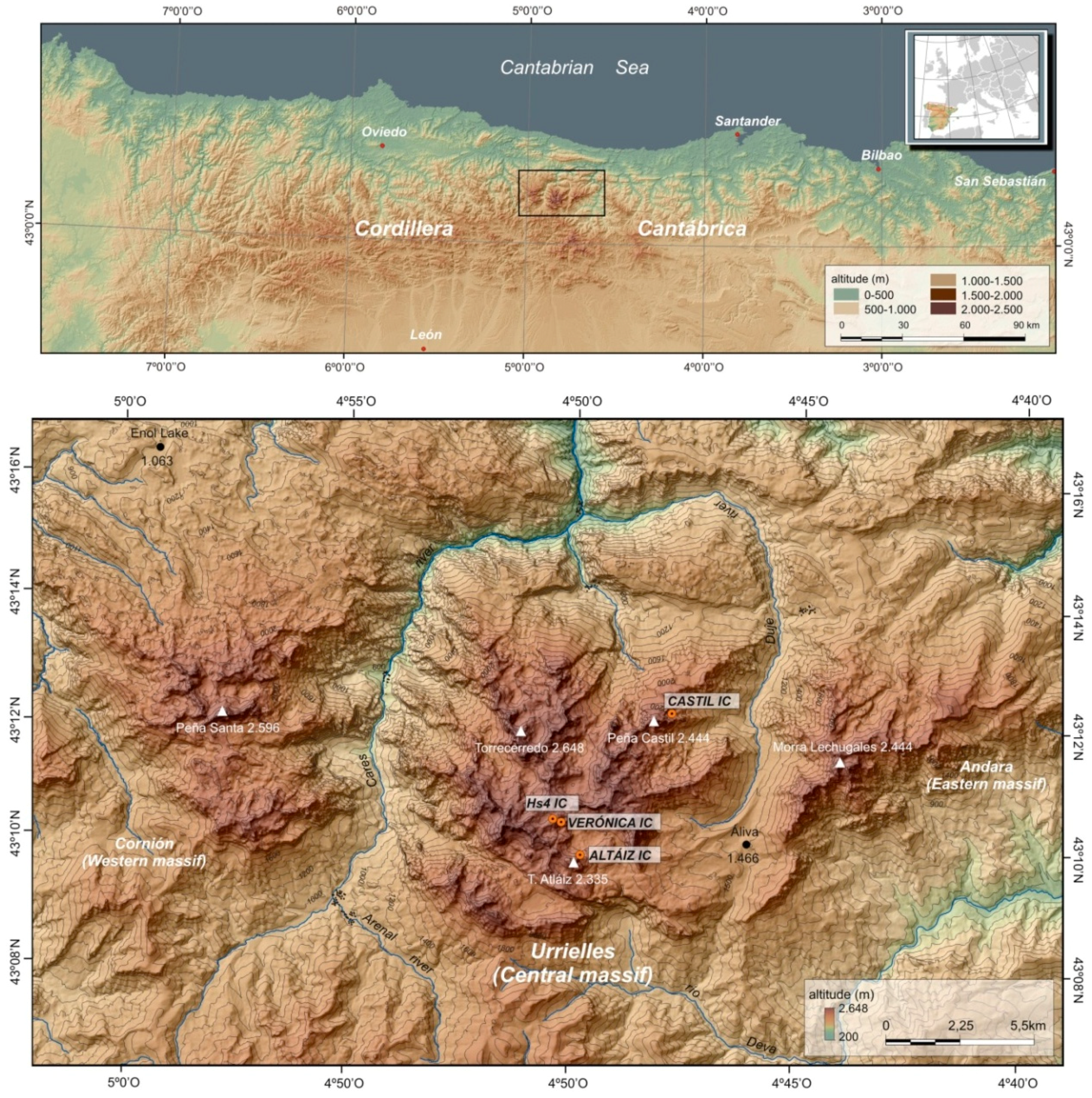
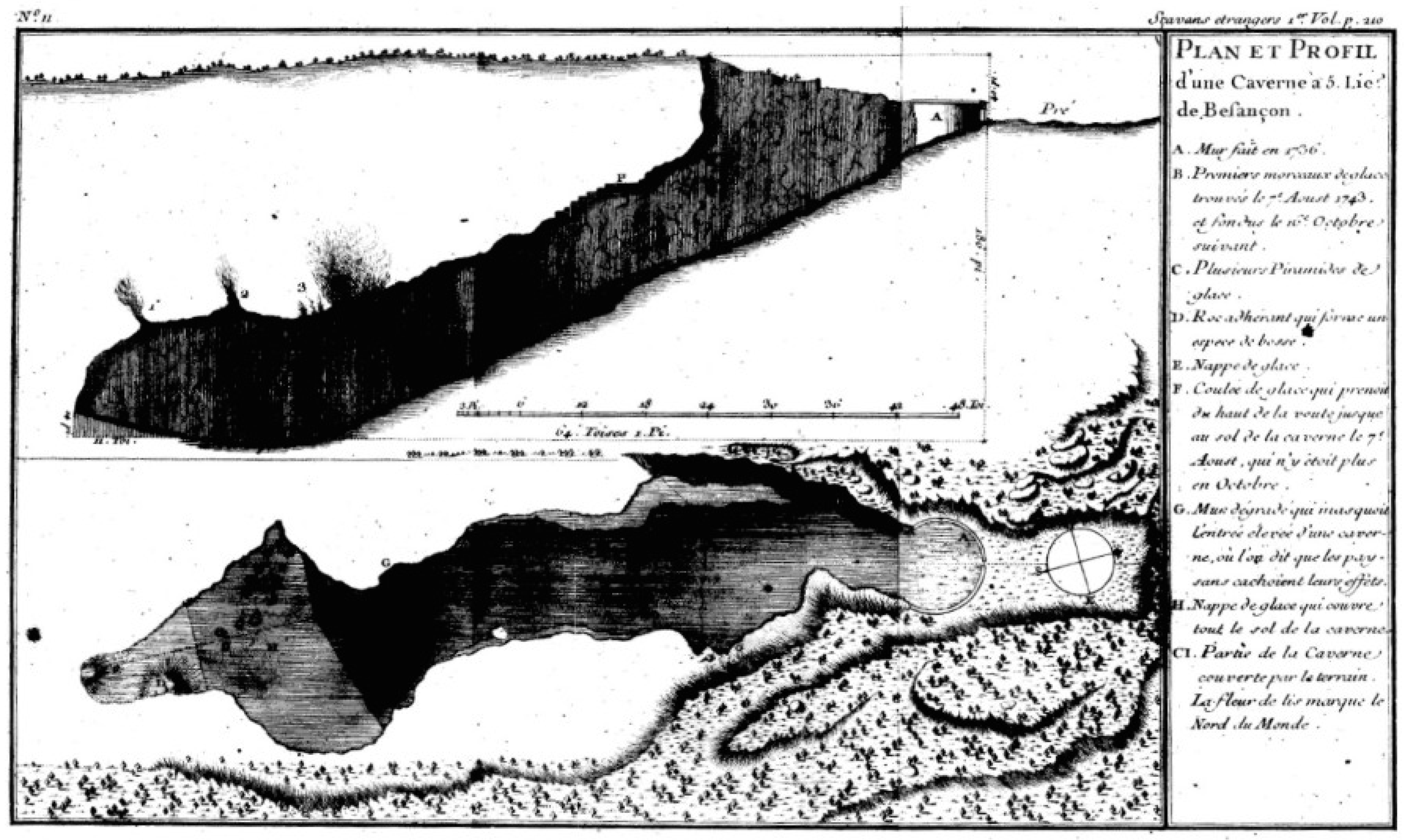
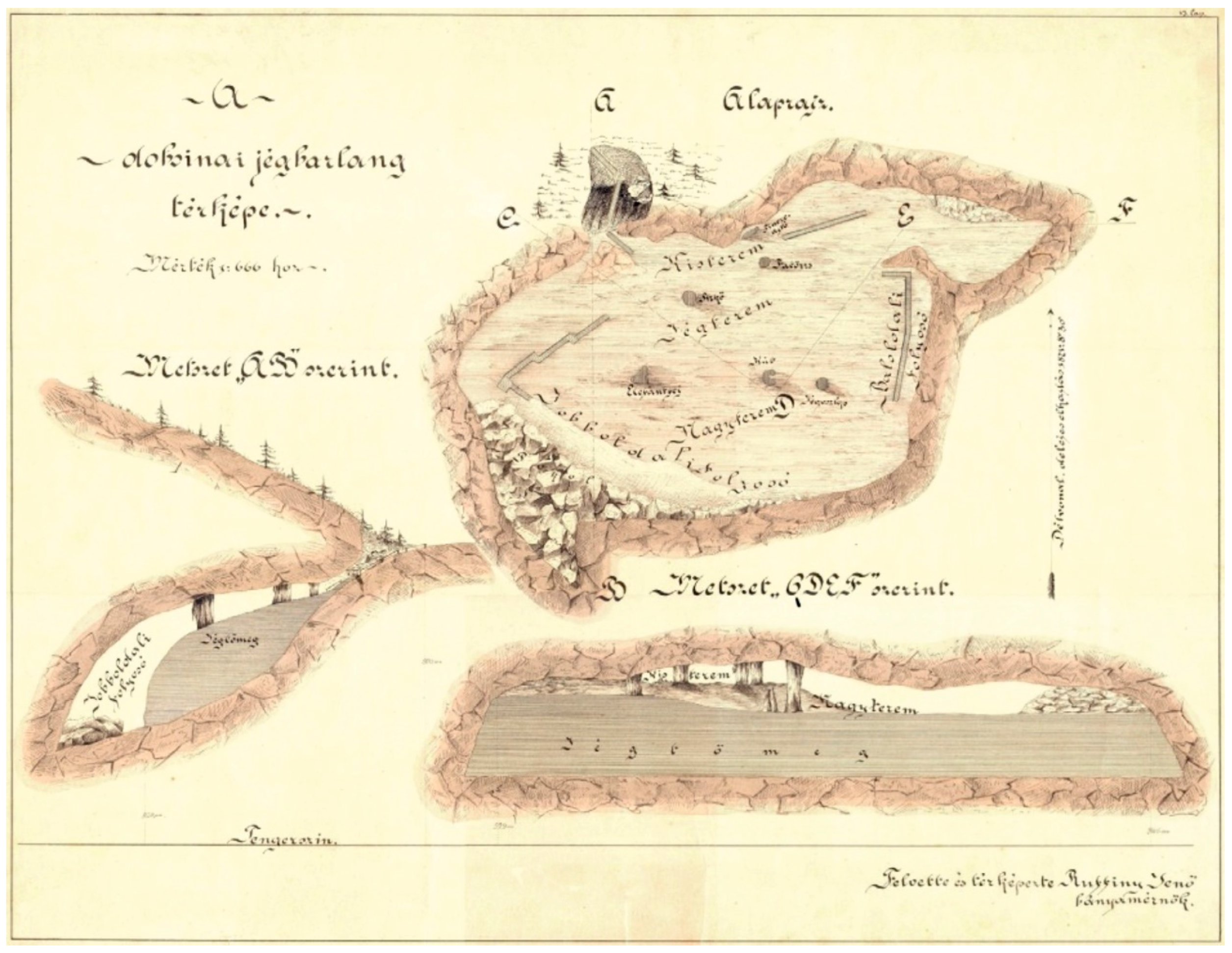

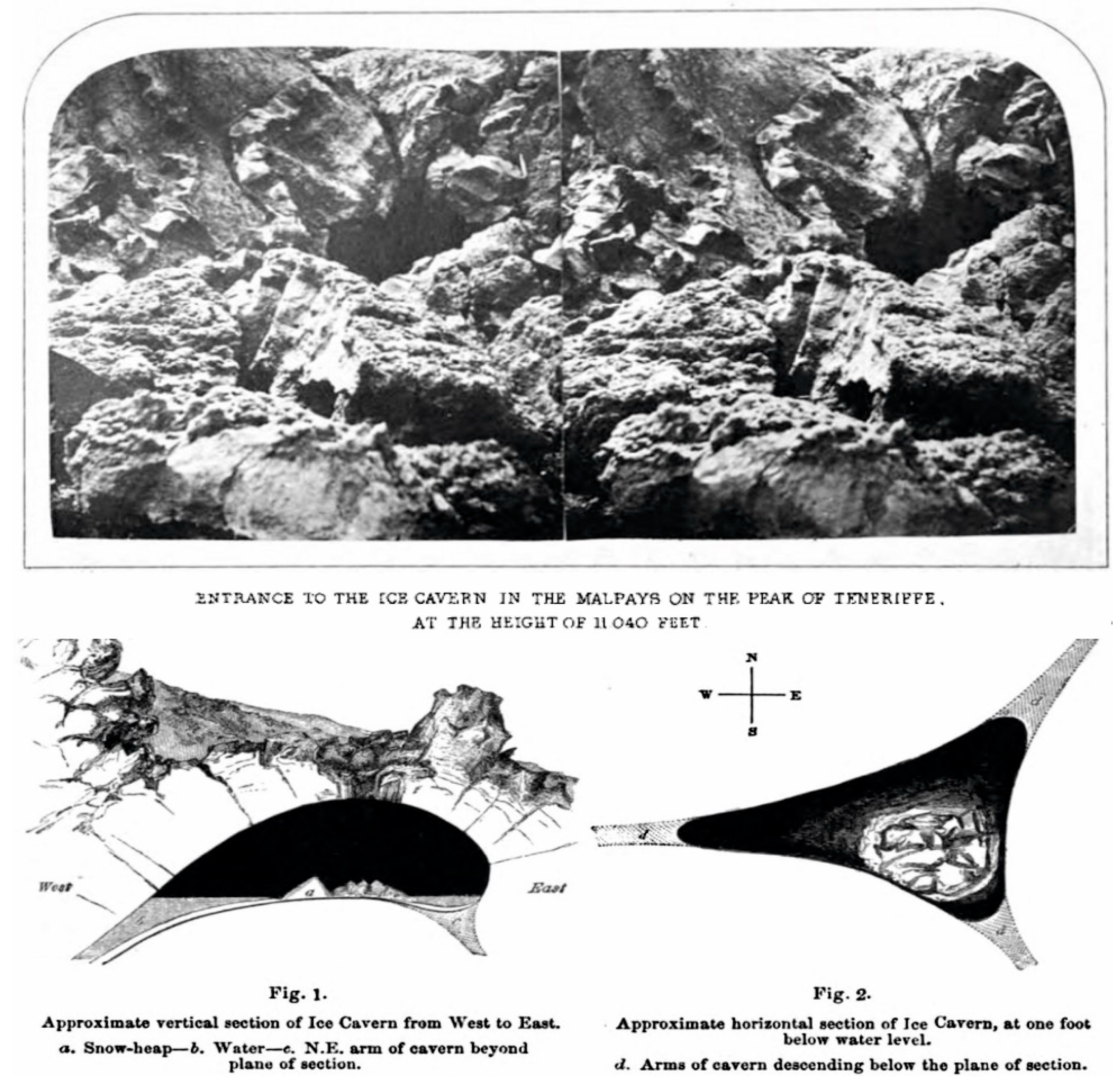
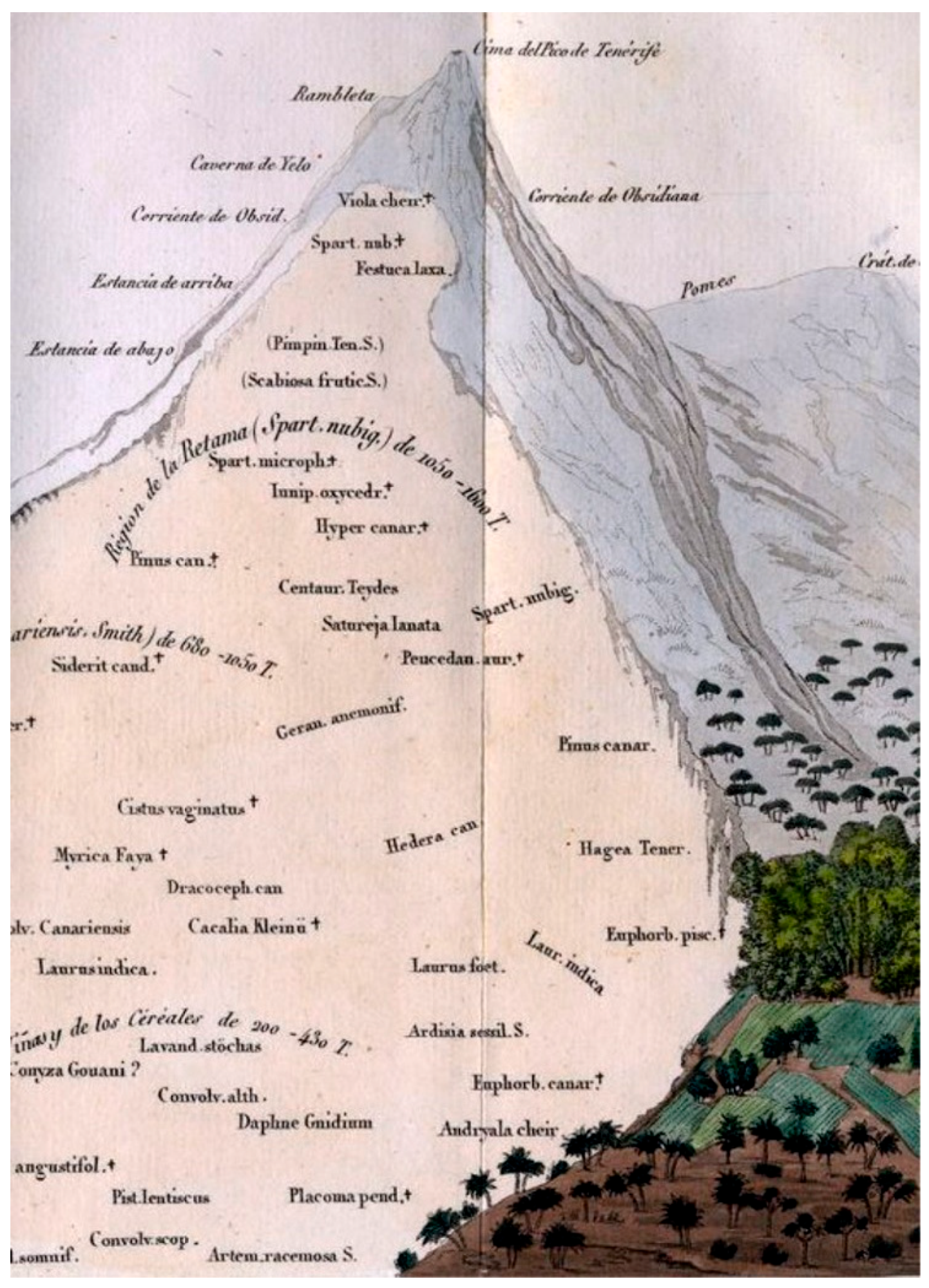
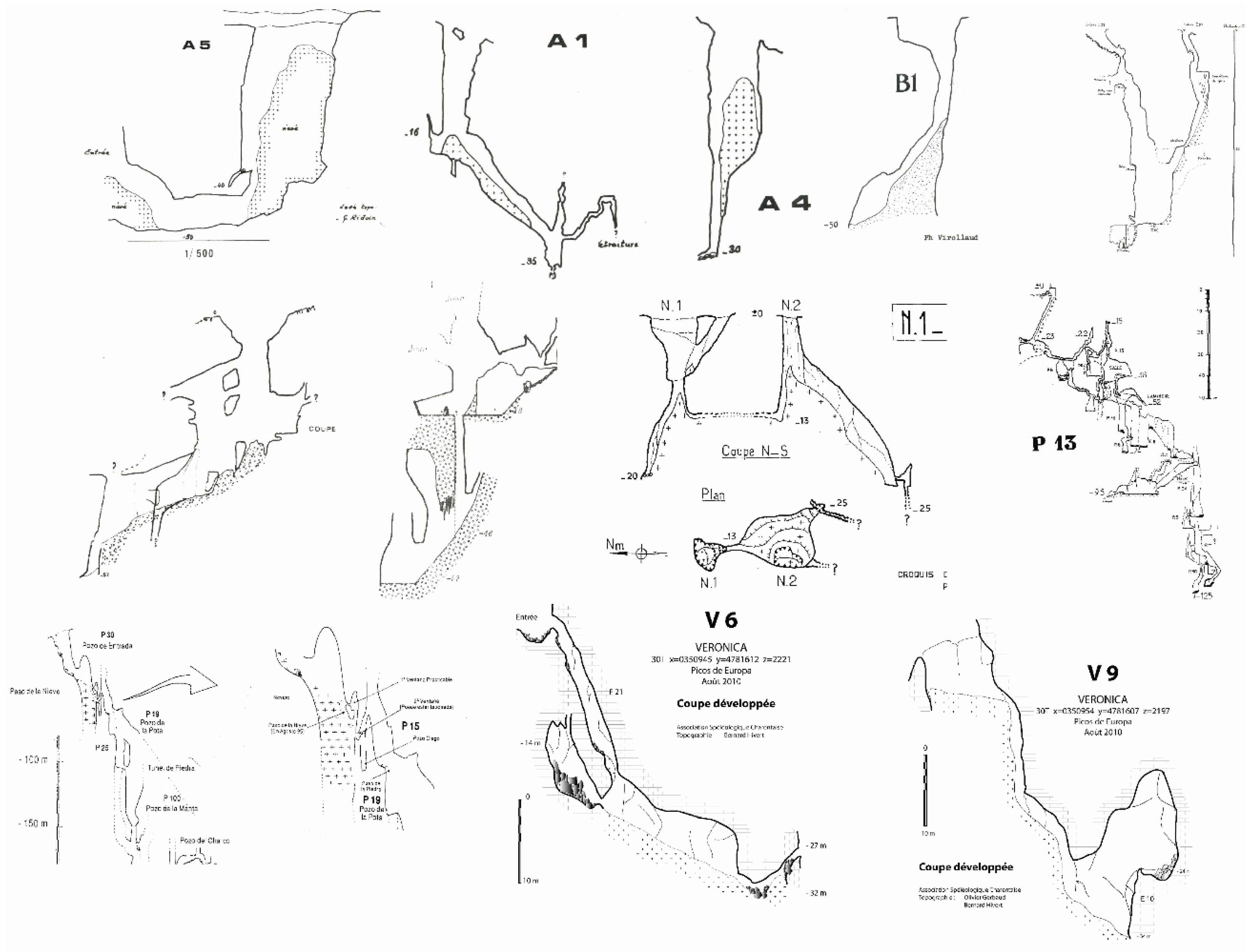
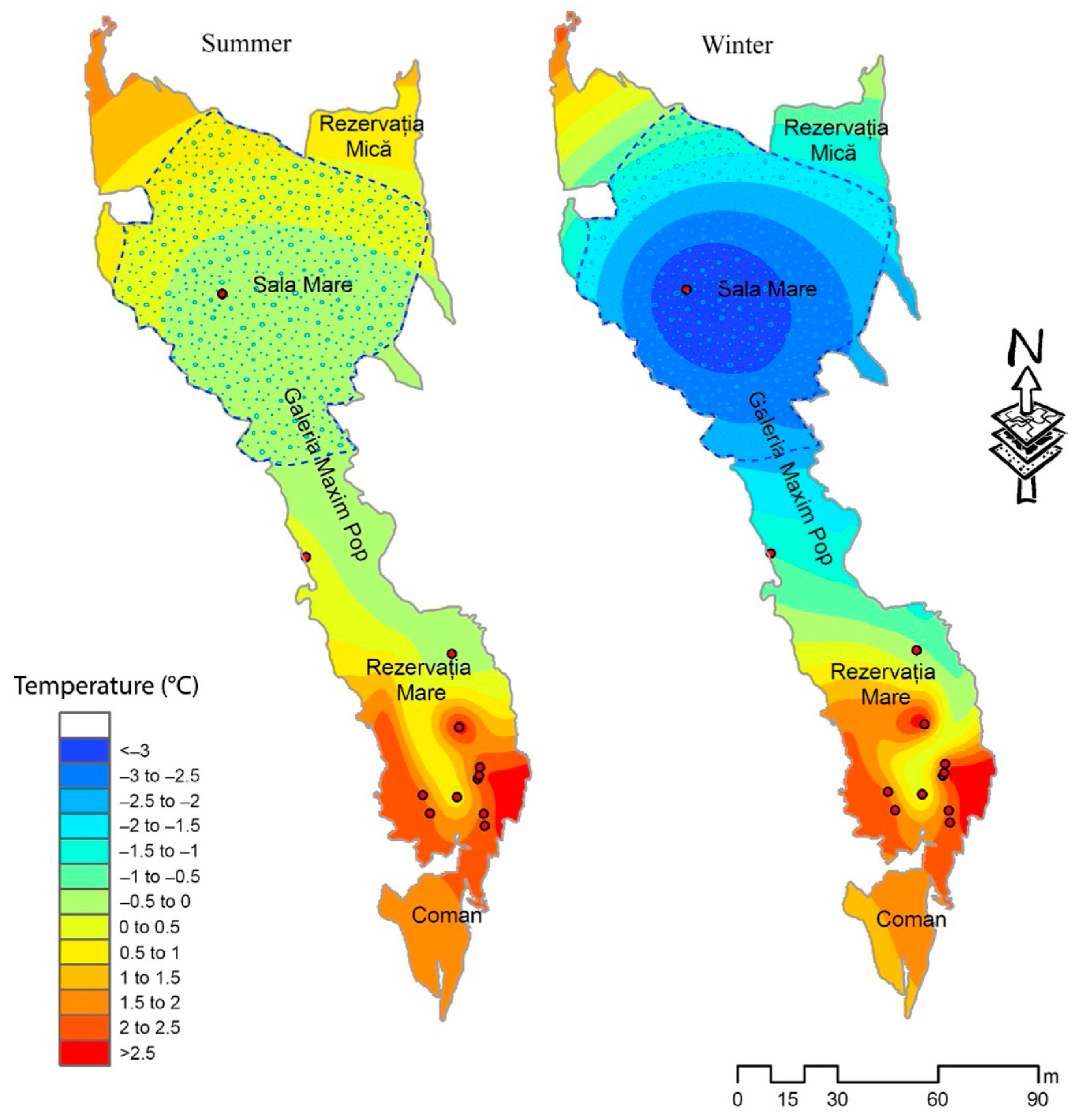
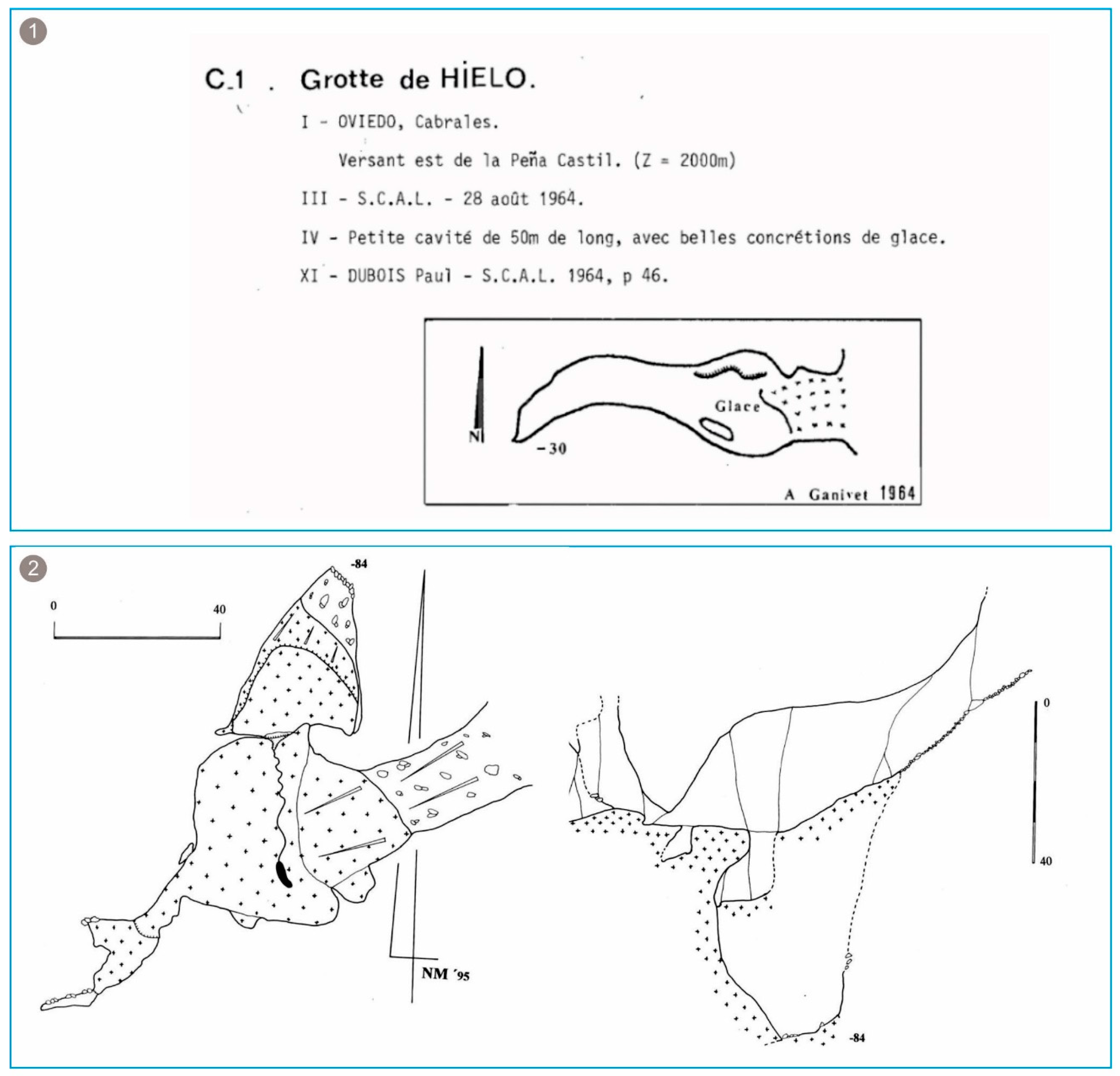
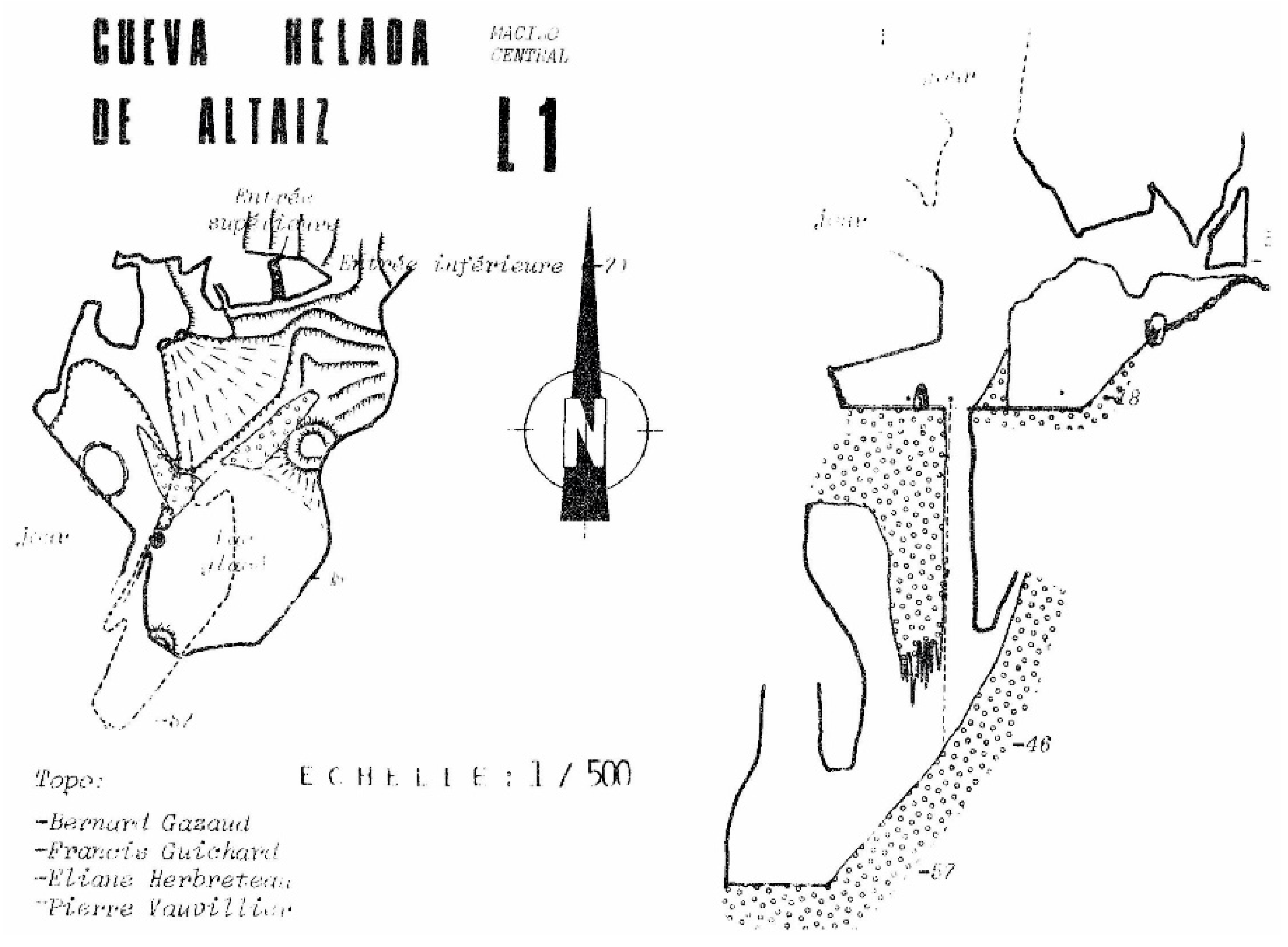
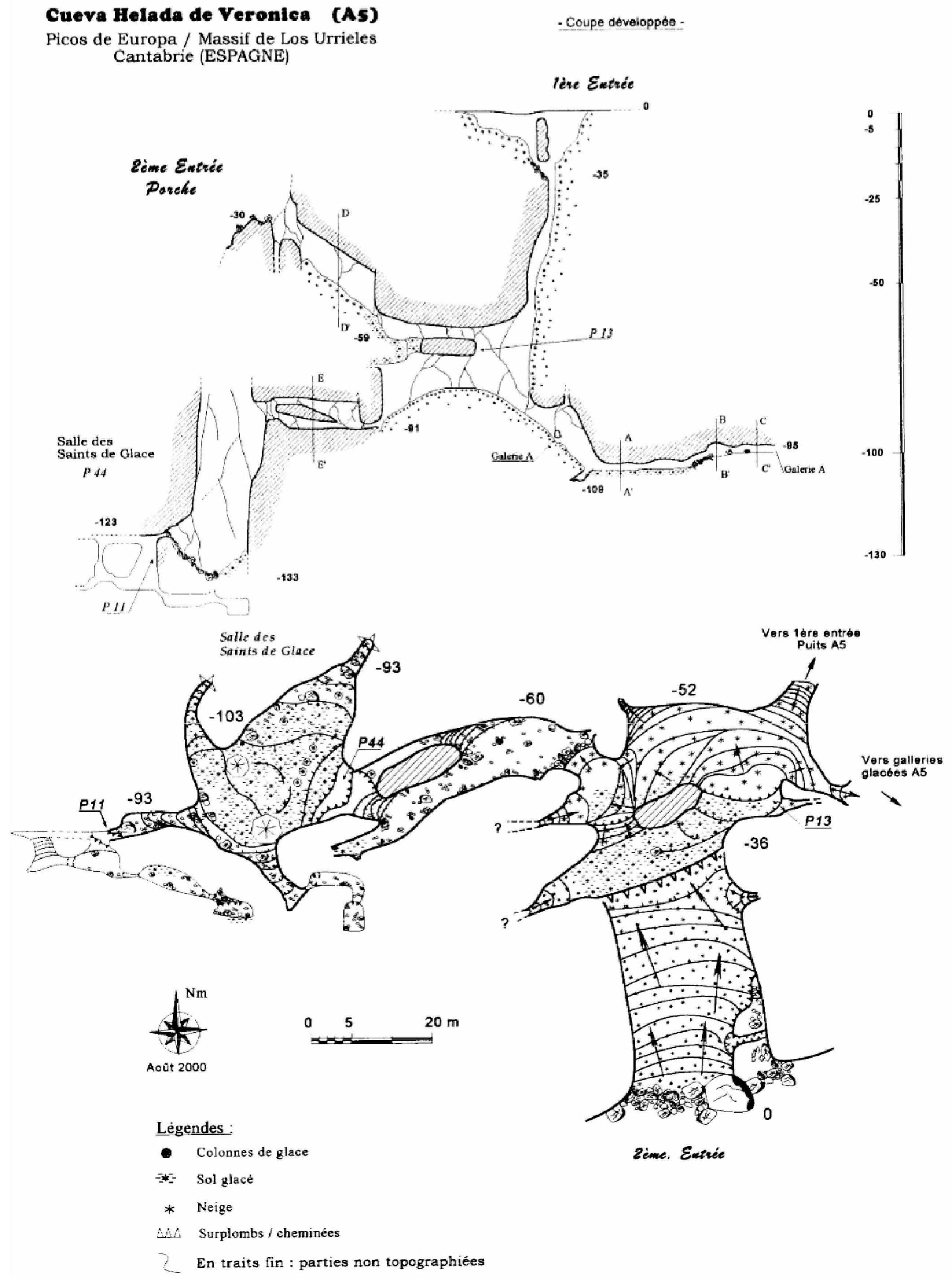
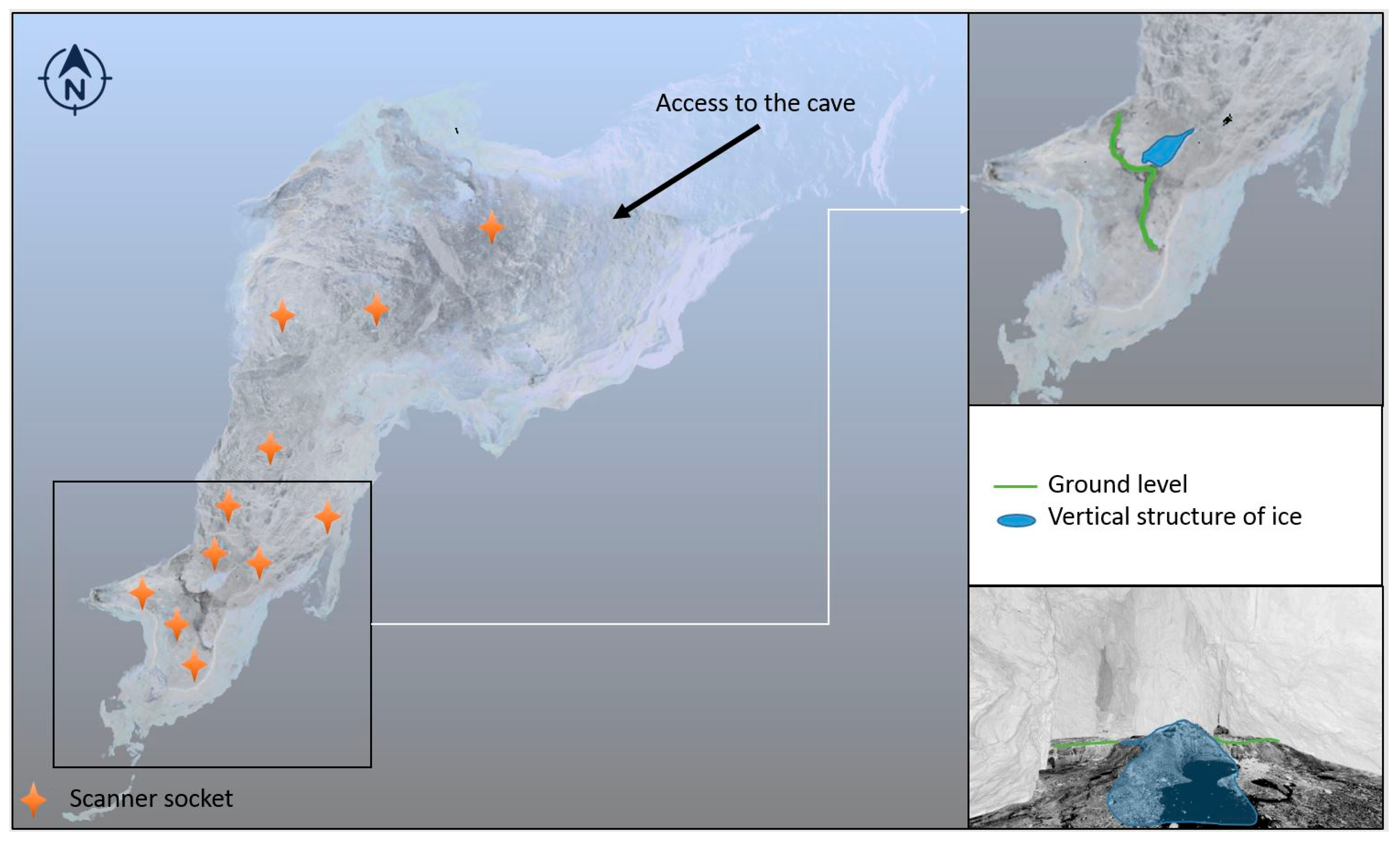
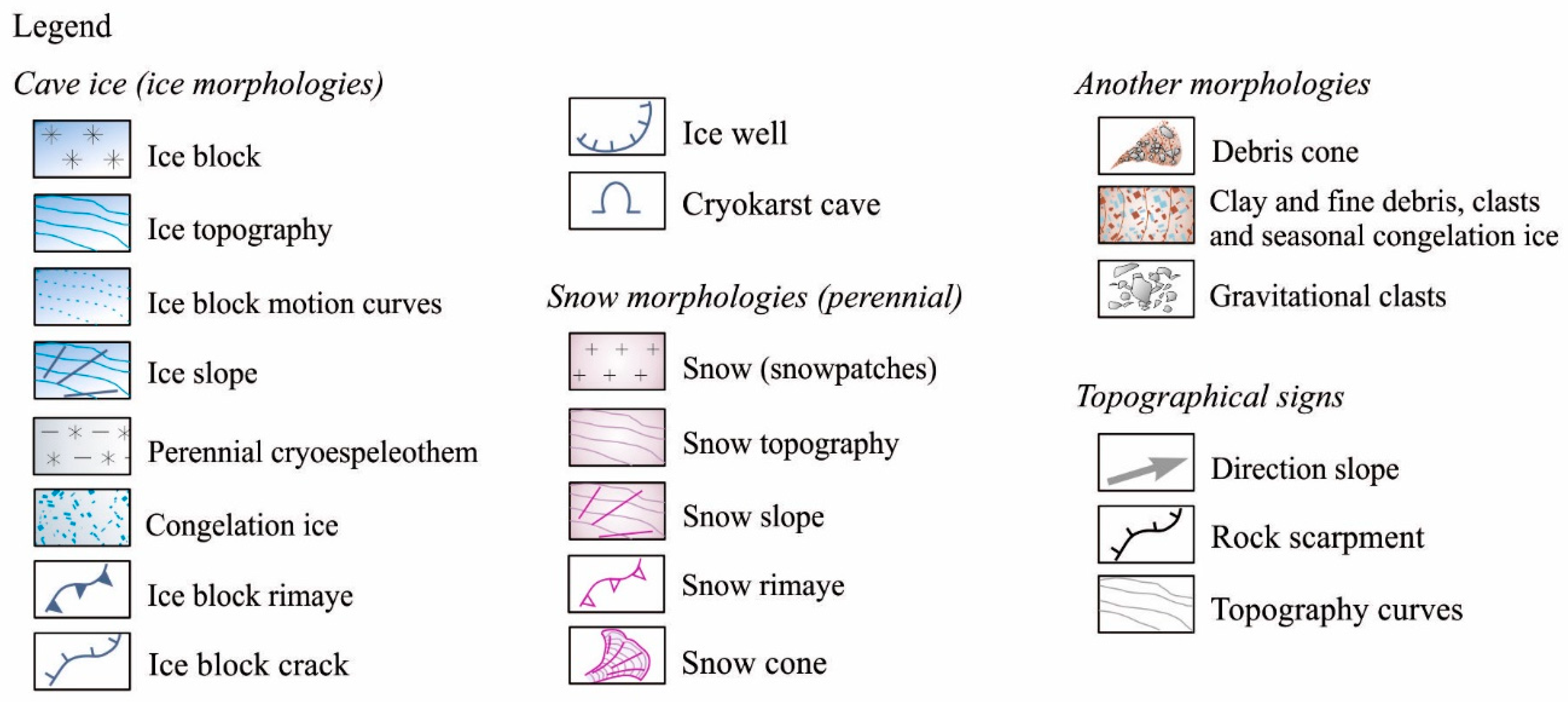
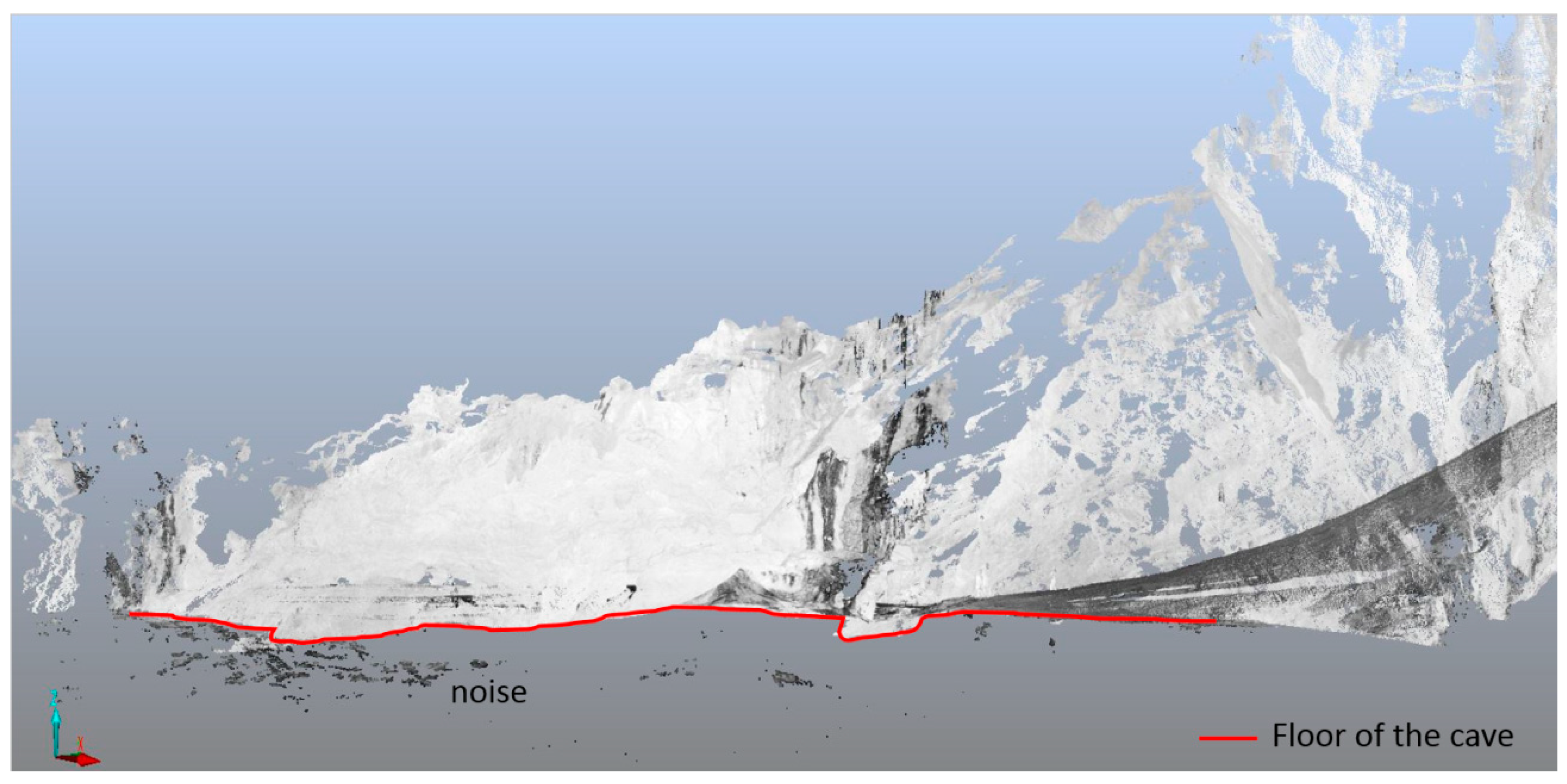
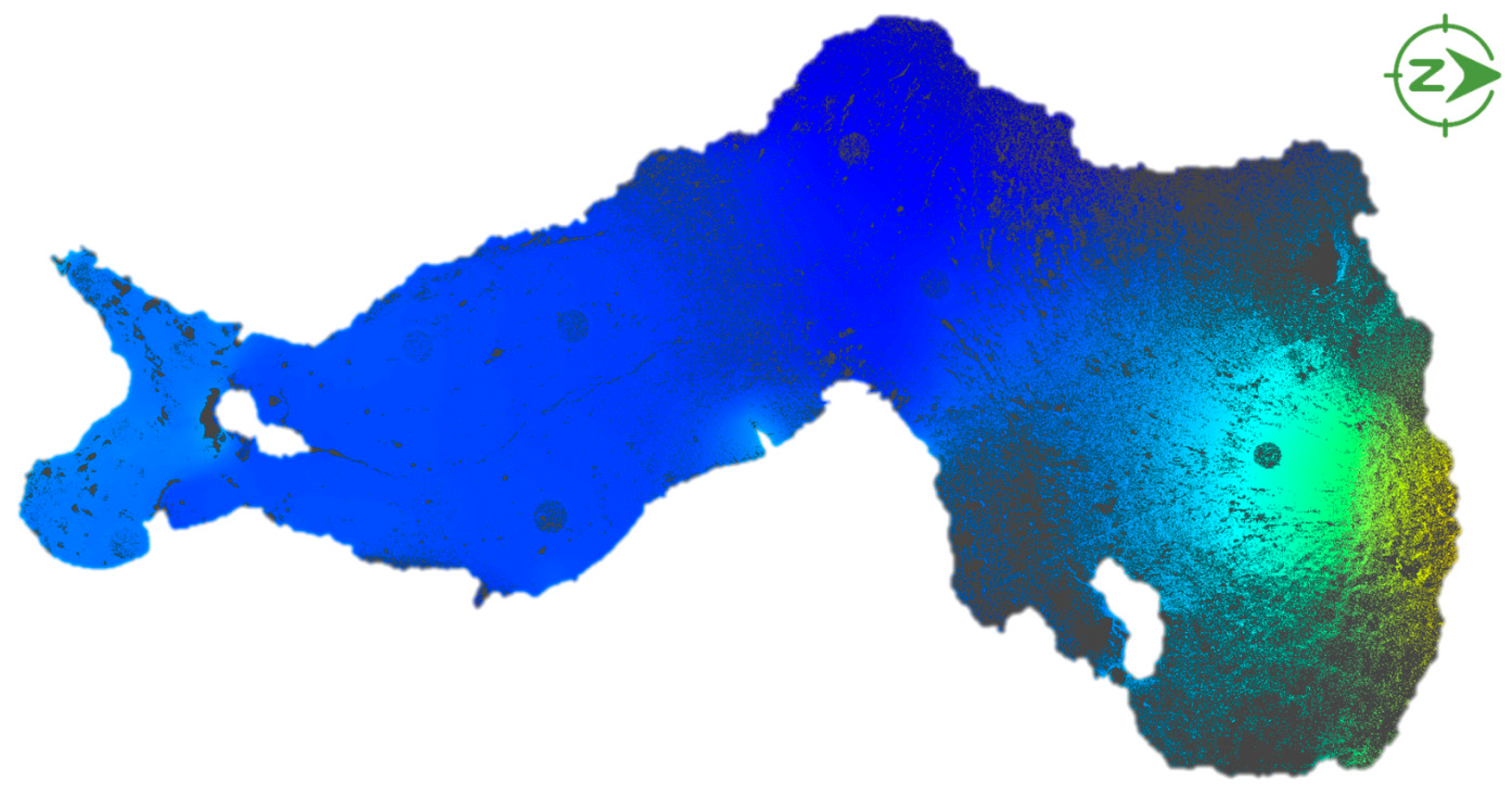
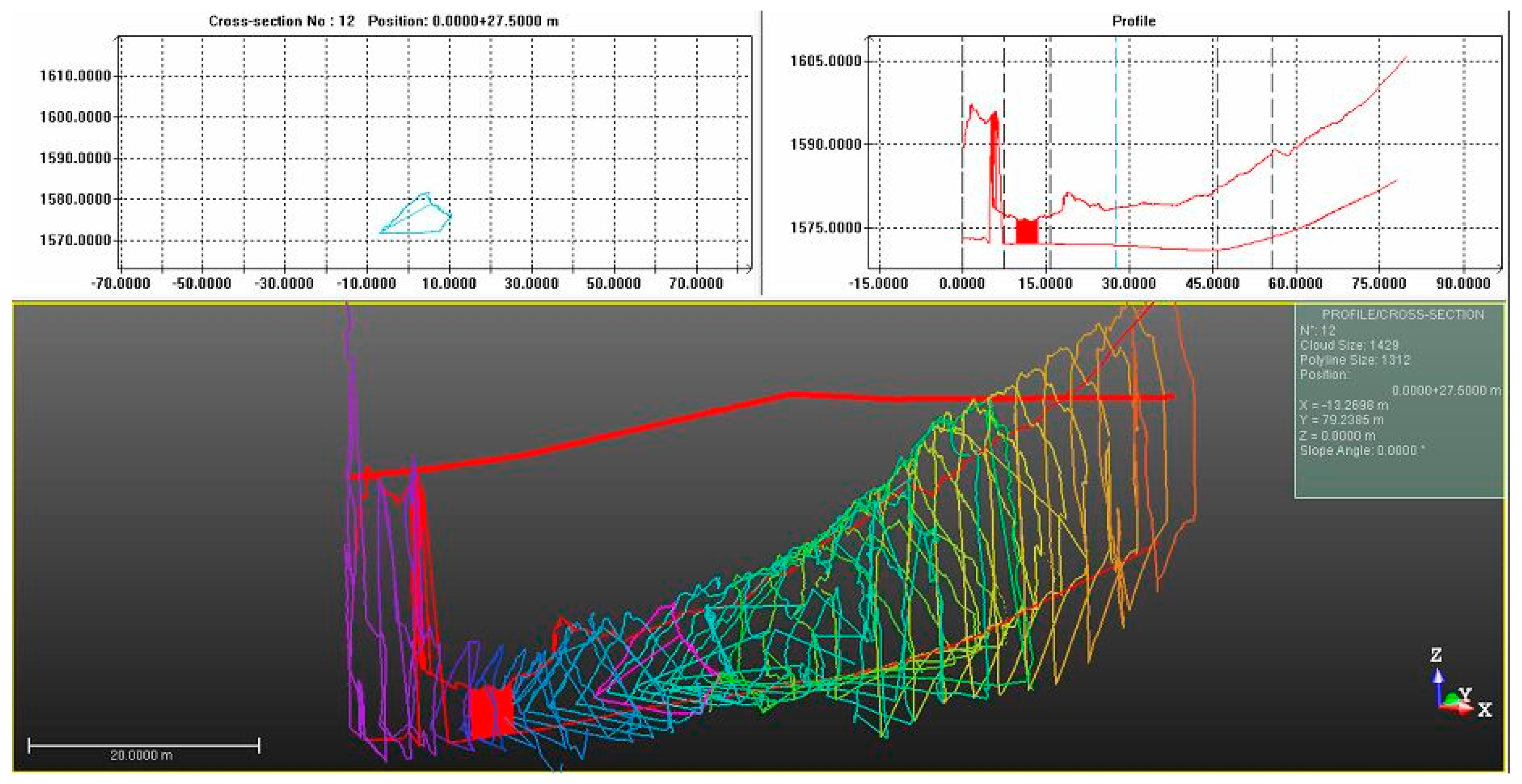
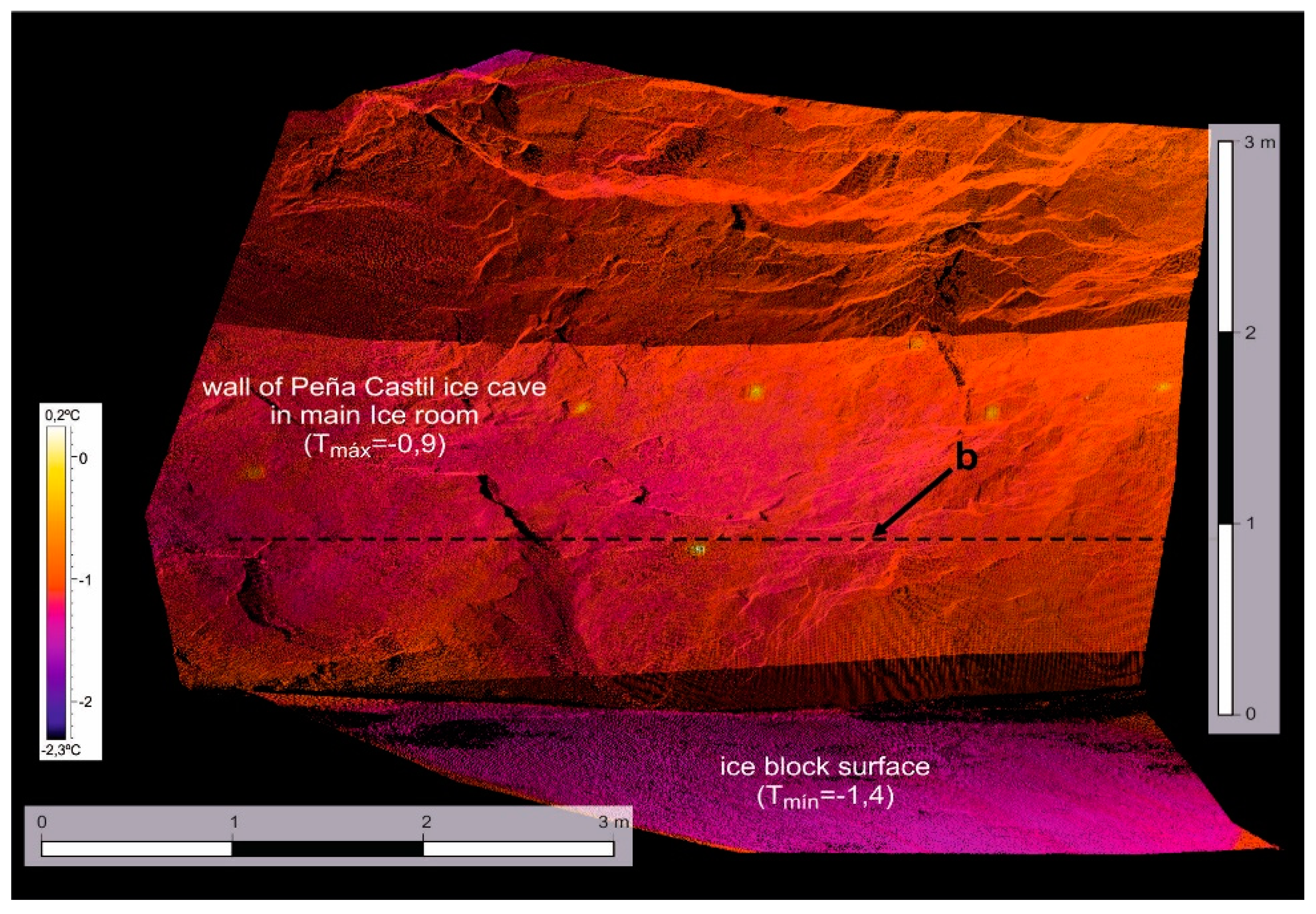
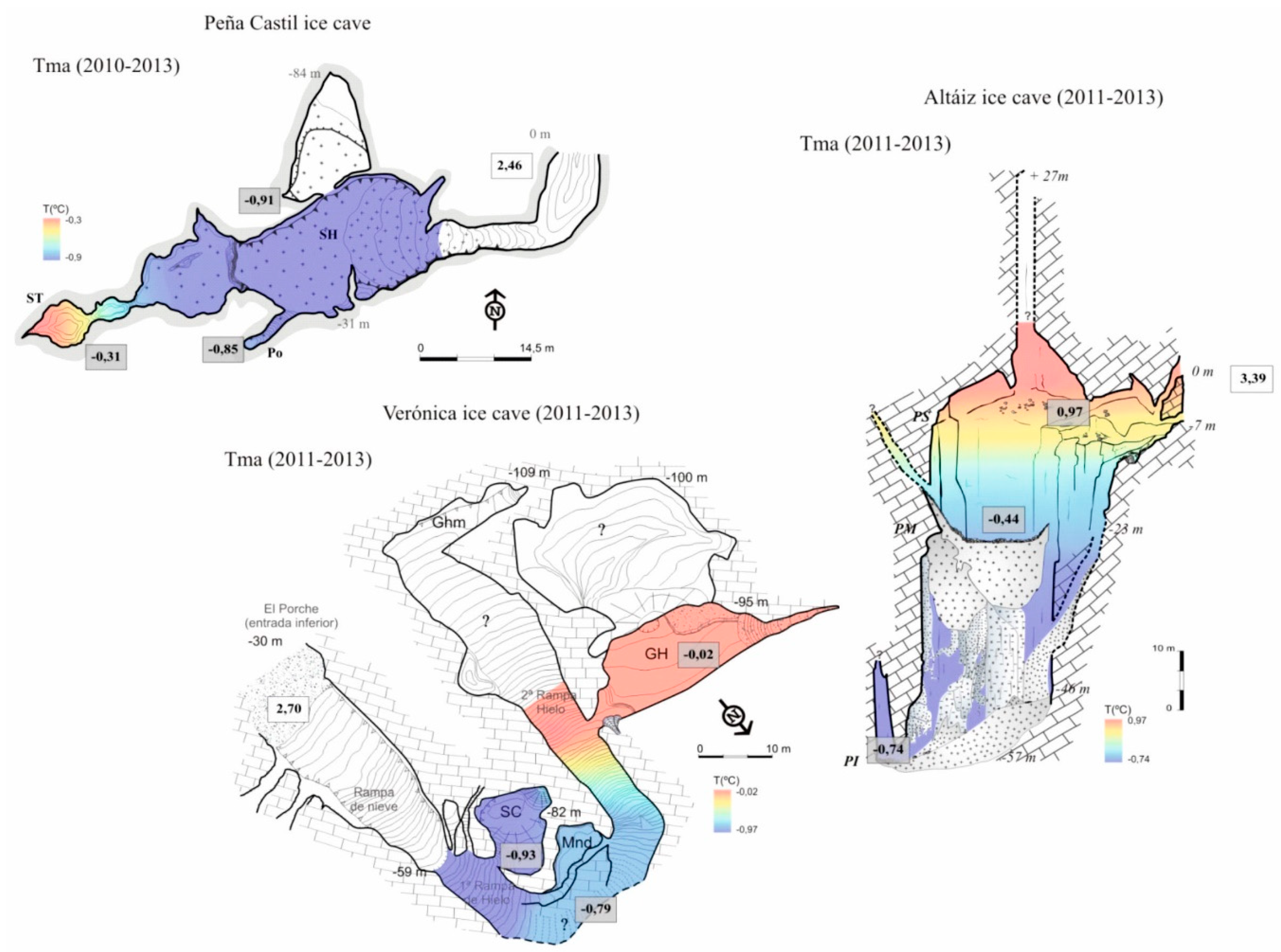
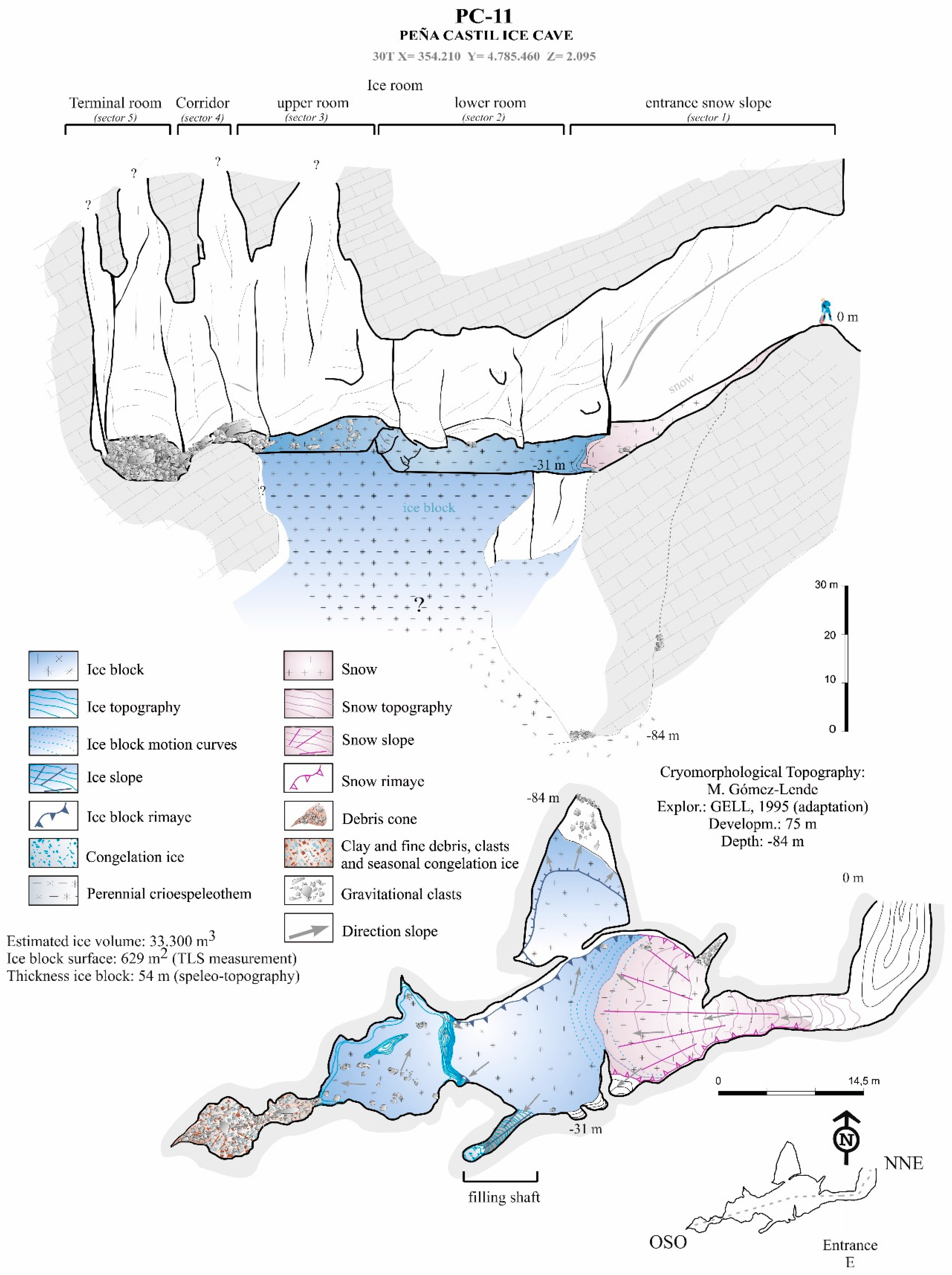
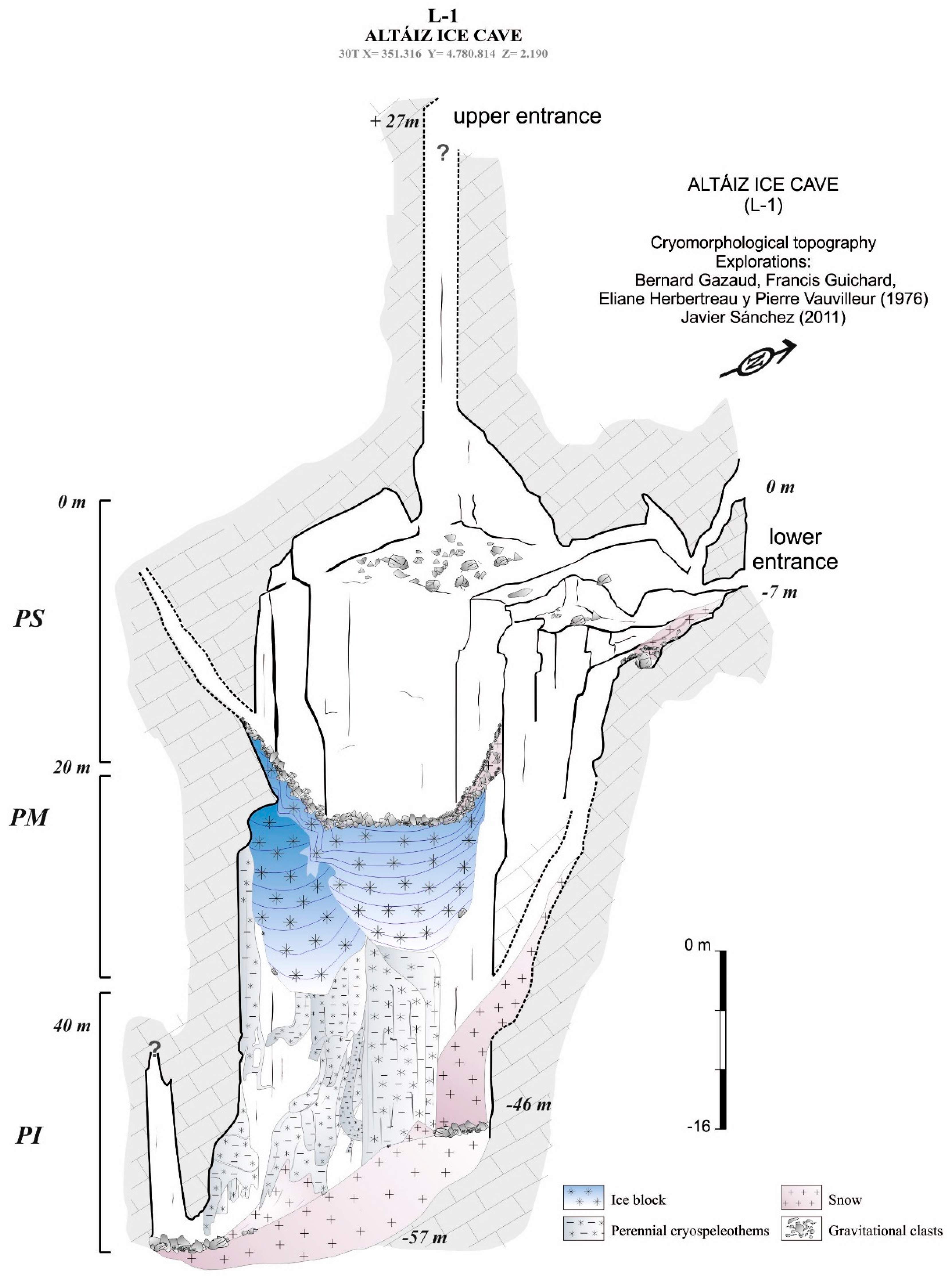
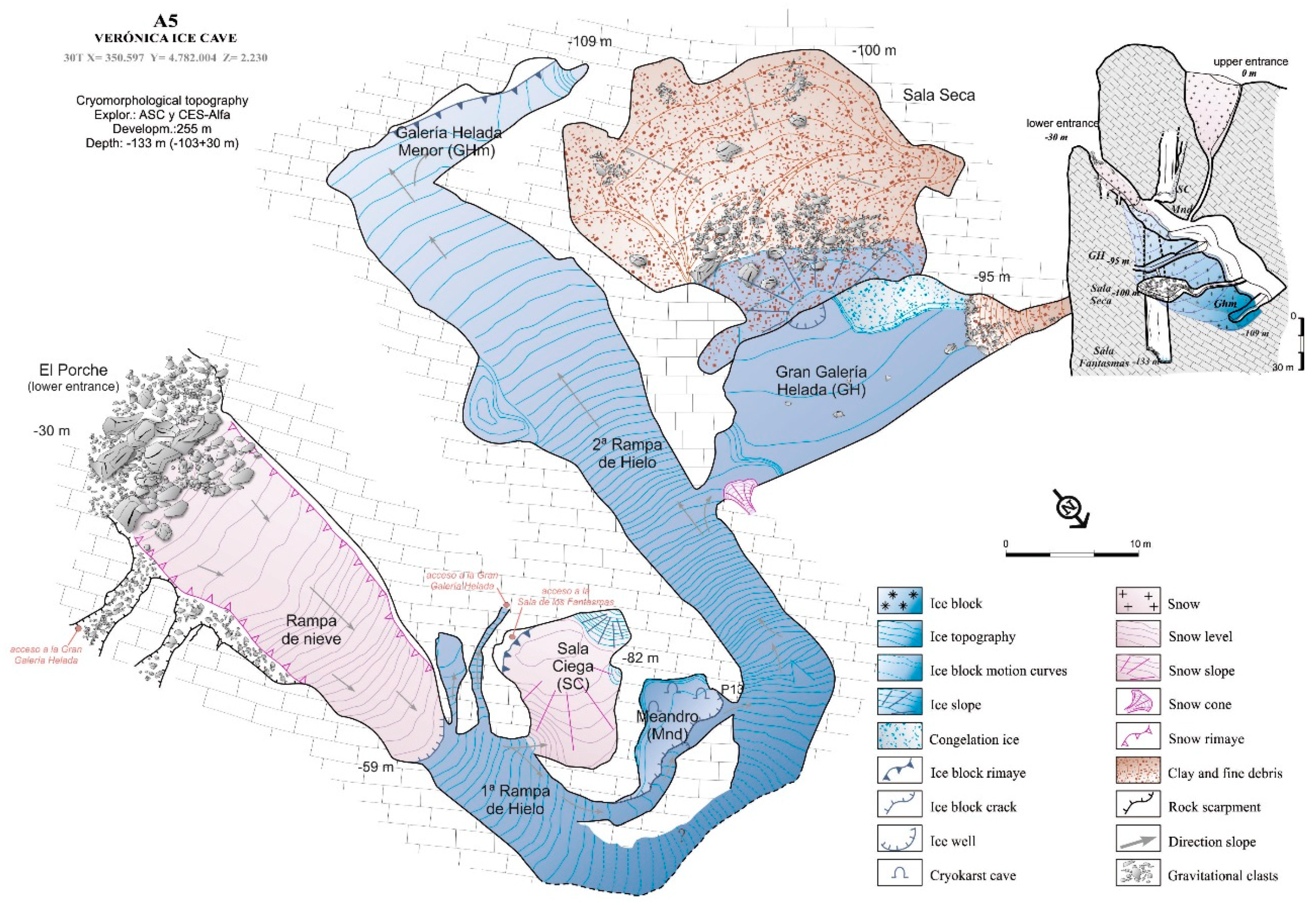
| Resolution | Points Distance (mm/10 m) | Quality | Timing Scan (mm:ss) |
|---|---|---|---|
| 1/20 | 30.68 | 4x | 1:17 |
| 1/16 | 24.54 | 4x | 1:26 |
| 1/10 | 15.34 | 4x | 2:08 |
| 1/8 | 12.27 | 4x | 2:47 |
| 1/5 | 7.67 | 4x | 3:17 |
| 1/4 | 6.163 | 3x | 4:34 |
| 1/4 | 6.163 | 4x | 8:09 |
| 1/2 | 3.06 | 4x | 29:37 |
| 1/1 | 1.53 | 4x | 1 h 55 min |
| Cluster | Overlap (%) | Mean Precision (mm) | N Used Ptos. | % Ptos with <4 mm Precision |
|---|---|---|---|---|
| 3 northern takes | 76.3 | 2.15 | 237.487 | 72.6 |
| 2 central takes | 73.4 | 6.03 | 65.785 | 62.2 |
| 6 southern takes | 67.3 | 4.22 | 487.248 | 59.5 |
| Ice cave | 34.9 | 6.77 | 36.805 | 30.8 |
© 2018 by the authors. Licensee MDPI, Basel, Switzerland. This article is an open access article distributed under the terms and conditions of the Creative Commons Attribution (CC BY) license (http://creativecommons.org/licenses/by/4.0/).
Share and Cite
Gómez-Lende, M.; Sánchez-Fernández, M. Cryomorphological Topographies in the Study of Ice Caves. Geosciences 2018, 8, 274. https://doi.org/10.3390/geosciences8080274
Gómez-Lende M, Sánchez-Fernández M. Cryomorphological Topographies in the Study of Ice Caves. Geosciences. 2018; 8(8):274. https://doi.org/10.3390/geosciences8080274
Chicago/Turabian StyleGómez-Lende, Manuel, and Manuel Sánchez-Fernández. 2018. "Cryomorphological Topographies in the Study of Ice Caves" Geosciences 8, no. 8: 274. https://doi.org/10.3390/geosciences8080274





